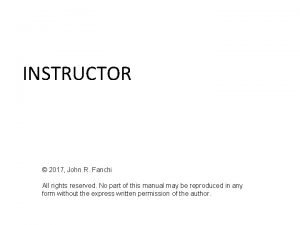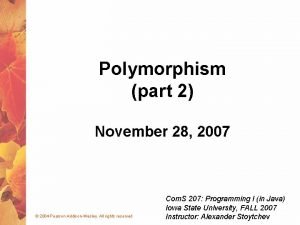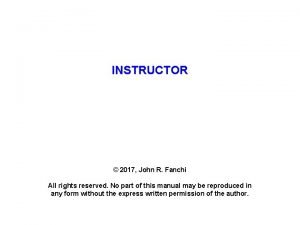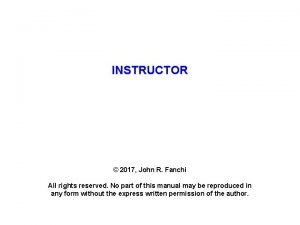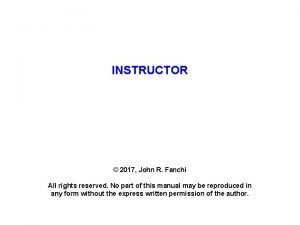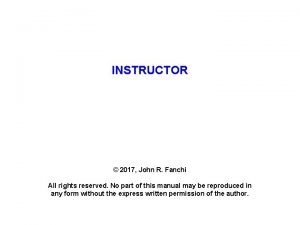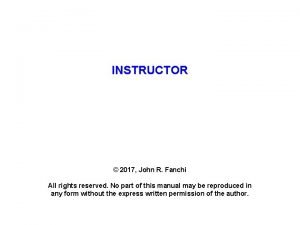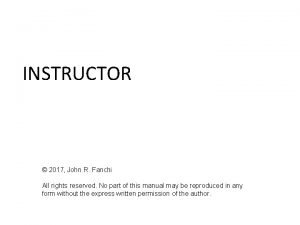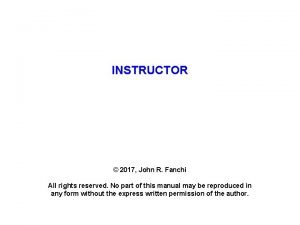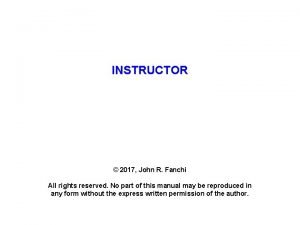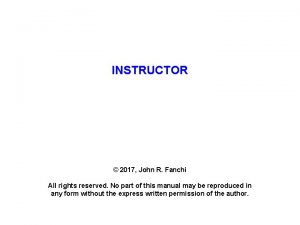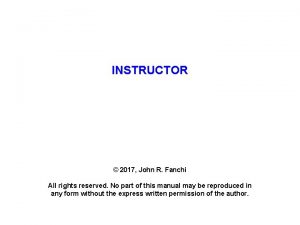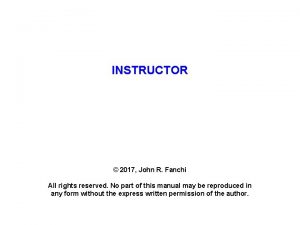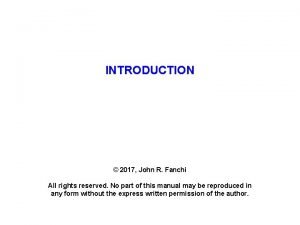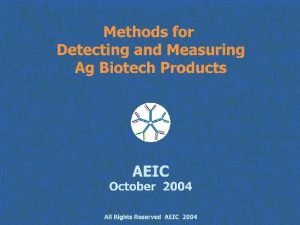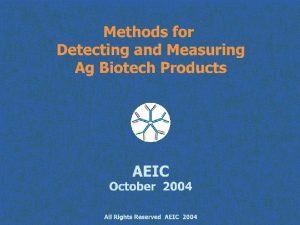INSTRUCTOR 2017 John R Fanchi All rights reserved















![Schilthuis Material Balance Equation [1961] Determine OOIP (N) Production Term Physical Significance Np Cumulative Schilthuis Material Balance Equation [1961] Determine OOIP (N) Production Term Physical Significance Np Cumulative](https://slidetodoc.com/presentation_image/0a979243f5b5bcda35ad6892fe7b9741/image-16.jpg)
























![Recovery Efficiencies for Different Depletion Drive Mechanisms [Data from Ahmed, 2000] Depletion Drive Mechanisms Recovery Efficiencies for Different Depletion Drive Mechanisms [Data from Ahmed, 2000] Depletion Drive Mechanisms](https://slidetodoc.com/presentation_image/0a979243f5b5bcda35ad6892fe7b9741/image-41.jpg)







- Slides: 48

INSTRUCTOR © 2017, John R. Fanchi All rights reserved. No part of this manual may be reproduced in any form without the express written permission of the author.

To the Instructor The set of files here are designed to help you prepare lectures for your own course using the text Introduction to Petroleum Engineering, J. R. Fanchi and R. L. Christiansen (Wiley, 2017) File format is kept simple so that you can customize the files with relative ease using your own style. You will need to supplement the files to complete the presentation topics.

PRODUCTION EVALUATION TECHNIQUES © 2017, John R. Fanchi All rights reserved. No part of this manual may be reproduced in any form without the express written permission of the author.

Outline Ø Field Performance Data Ø Decline Curve Analysis Ø Material Balance Ø Oil Reservoir Material Balance Ø Gas Reservoir Material Balance Ø Drive Mechanisms Ø Inflow Performance Relationships Homework: IPE Ch. 13

FIELD PERFORMANCE DATA

Well Surveillance – Oil Wells Ø Rapid decline in total fluid production due to Ø Artificial lift problem Ø Formation damage Ø Offset well effects (interference) Ø Rapid decline in oil and increase in water due to Ø Casing leak Ø Watered out Ø Forecast production with Decline Curve Analysis

DECLINE CURVE ANALYSIS

Decline Curve with Solutions Decline Curve Harmonic Decline (n = 1) Hyperbolic Decline (0 < n < 1) Exponential Decline (n = 0)

Exponential Decline Curve Analysis Ø Exponential (often used) Ø Ø Ø Decline rate (% per year) Straight Line on Semi-log plot Economic limit required Assumes no water drive (water influx) Must know reservoir conditions and area Decline Factor Cumulative Production

Probabilistic DCA Workflow Gather rate-time data Specify input parameter distributions Uniform Triangle Specify constraints Constraint Options Objective Function Gas Rate Cum Gas Apply Constraints (Select Subset) Generate Range of Decline Curves Generate EUR distribution for subset Determine P 10, P 50, P 90

MATERIAL BALANCE

Material Balance Concept Ø Apply conservation of mass to reservoirs and aquifers. Ø Assumptions: Ø Reservoir space voided by production is immediately filled Ø Remaining fluids and rock expand to completely fill space Ø Reservoir fluids in phase equilibrium Ø Instantaneous equilibrium Ø Single, weighted average pressure Ø Pressure gradients not considered Ø Fluid saturations uniform Ø Saturation gradients not considered Ø Conventional PVT relationships applicable

Uses of Material Balance Ø Determine OGIP and OOIP Ø Determine drive mechanisms Ø Quantify importance of each Ø Predict future reservoir behavior Required Data Ø Average reservoir pressures Ø Cumulative fluid production at the same times Ø PVT data and formation compressibility

OIL RESERVOIR MATERIAL BALANCE

Oil Material Balance Equation Ø Determine OOIP Ø Determine drive mechanisms Ø Quantify importance of each Ø Predict future reservoir behavior Required Data Ø Average reservoir pressures Ø Cumulative fluid production at the same times Ø PVT data and formation compressibility
![Schilthuis Material Balance Equation 1961 Determine OOIP N Production Term Physical Significance Np Cumulative Schilthuis Material Balance Equation [1961] Determine OOIP (N) Production Term Physical Significance Np Cumulative](https://slidetodoc.com/presentation_image/0a979243f5b5bcda35ad6892fe7b9741/image-16.jpg)
Schilthuis Material Balance Equation [1961] Determine OOIP (N) Production Term Physical Significance Np Cumulative oil produced Gp Cumulative gas produced Wp Cumulative water produced

Express Schilthuis MBE Using Volume Changes Term Define Volume Changes NDo Change in volume of initial oil and associated gas NDgo Change in volume of free gas N(Dw + Dgw) Change in volume of initial connate water NDr Change in formation pore volume

Express Schilthuis MBE Using Drive Indices Define DHC (RHS of Schilthuis MBE) Divide by DHC to obtain sum of drive indices = 1 Relative magnitude of index indicates importance of drive mechanisms Term Drive Index Solution Gas Isg = NDo / DHC Gas Cap Igc = NDgo / DHC Water Iw = [(We - Wp)Bw] / DHC Injected Fluids Ii = [Wi. Bw + Gi. B g] / DHC Connate Water and Rock Expansion Ie = [N(Dw + Dgw) + NDr] / DHC

GAS RESERVOIR MATERIAL BALANCE

Gas Compressibility Factor

Gas Formation Volume Factor

Gas Reservoir Recovery Efficiency Ultimate Recovery Efficiency:

Gas Reservoir Material Balance Ø Gas reservoir with water influx: where We = cumulative water influx Wp = cumulative water production We-Wp = net influx Bw = water FVF Bg = gas FVF Bgi = gas FVF at initial pressure G = OGIP Gp = cumulative gas production

Depletion Drive Gas Reservoirs Ø High recovery efficiencies (80 to 90%) 1. Gas has very low viscosity and high mobility 2. Gas is very compressible and expandable Ø Gas wells are drilled on larger spacing than oil wells Ø Water and formation compressibilities are usually neglected in gas material balance calculations Ø Water and formation compressibility << gas compressibility

Gas Reservoir Material Balance (p/Z) Equation Ø Cumulative gas production: Ø Note linear relationship between p/Z and GP.

Water - Drive Ø Aquifers flatten p/Z curve A. Depletion Drive (straight line) B. Partial Water Drive C. Strong Water Drive; Full Pressure Maintenance p/Z C B A Cum. Gas Production

Practical Considerations Ø In practice, several factors may cause p/Z vs Cum. Prod. plot to be nonlinear 1. Average reservoir pressure may not be well known 2. Water drive present 3. If formation compressibility significant, extrapolation will give optimistically high OGIP

Depletion Drive Gas Reservoir Ø No water influx – depletes like “tank” Ø High recoveries – up to 95% for non-water drives

DEPLETION DRIVE MECHANISMS AND RECOVERY EFFICIENCIES

Primary Production Drive Mechanisms

Solution Gas Drive Ø Also called Depletion Drive or Dissolved Gas Drive Ø Gas comes out of solution in the oil – “pushes” oil toward producing wells Ø Rapid decline of oil and rapid increase of GOR Ø Pressure in reservoir depletes quickly Ø 15% typical oil recovery factor Ø Sometimes make good waterflooding candidates

Solution Gas Drive GOR Reservoir Pressure Oil Rate Time Start undersaturated; then drop below bubble point pressure

Gas Cap Drive Ø Gas cap helps maintain reservoir pressure and assists in “pushing” oil toward wells Ø Must not produce gas cap to maximize oil recovery Ø Gas-Oil contact eventually reaches wells and GOR goes up rapidly. Ø Typically oil recovery is around 25%

Gas Cap Mechanism Ø Oil is saturated (full of gas) and leftover gas rises to make gas cap layer Ø 2 Stage Depletion Management: Ø Produce only oil portion at first to let gas drive oil to the wells (maintains pressure) Ø Blowdown gas cap when oil is depleted later in reservoir life Ø GOR stays lower until gas-oil contact reaches wells then rapidly rises

Gas Cap Drive GOR Reservoir Pressure Oil Rate Time Start with free gas; first produce oil; then produce oil and free gas

Water Drive Ø Reservoir contains bottom water Ø Water moves when oil is produced Ø Reservoir pressure and GOR do not decline much throughout field life

Water Drive (cont. ) Ø “Nature’s waterflood” Ø Do not produce oil too quickly Ø Minimize trapping oil with water encroachment Ø Oil well rapidly changes from mostly oil to mostly water (weeks to months) when oil-water contact reaches perfs Ø Must handle produced water Ø Typically recover 50% of oil

Water Drive Reservoir Pressure Water Cut GOR Oil Rate Time Start undersaturated; first produce oil; then produce oil and water

Managing Water Drives Ø Oil-Water Drives Ø Want to produce slowly to avoid pulling in water ahead of oil (like in East Texas Field) Ø Water (the driving fluid) is thinner than oil Ø Gas-Water Drives Ø Want to produce gas quickly to out run water Ø Gas is much thinner than water (driving fluid)

Compare Drives Solution Gas Drive Gas Cap Drive GOR Pressure Oil Rate Time Water Drive Time Pressure Water Cut GOR Oil Rate Time
![Recovery Efficiencies for Different Depletion Drive Mechanisms Data from Ahmed 2000 Depletion Drive Mechanisms Recovery Efficiencies for Different Depletion Drive Mechanisms [Data from Ahmed, 2000] Depletion Drive Mechanisms](https://slidetodoc.com/presentation_image/0a979243f5b5bcda35ad6892fe7b9741/image-41.jpg)
Recovery Efficiencies for Different Depletion Drive Mechanisms [Data from Ahmed, 2000] Depletion Drive Mechanisms Recovery Efficiency (% OOIP) Water drive 35 – 75 Gas cap drive 20 – 40 Solution gas drive 5 – 30 Note: Percentages indicated are for comparison only since recovery factors vary widely among reservoirs

INFLOW PERFORMANCE RELATIONSHIPS

Nodal Analysis and PI qfluid Tubing Casing pwf Reservoir pres

Typical TPC* Curve for Production Wells Unstable Flow Stable Flow pwf TPC (outflow) qfluid *TPC = Tubing Performance Curve

IPR vs TPC pwf IPR (inflow) pres TPC (pwf at qfluid = 0) (outflow) pwf, op qfluid Ø IPR = Inflow Performance Relationship Ø Note: In IPR curve, qfluid = 0 at pwf = pres Ø TPC = Tubing Performance Curve Ø Operating qfluid, op and pwf, op at intersection of IPR and TPC curves

Multiphase Flow In Tubing Ø Factors effecting multiphase flow in tubing Ø Flow rate Ø Critical velocity Ø Flow rate high enough to lift liquid Ø Erosional velocity Ø Flow rate low enough to minimize tubing damage Ø Flow pattern Ø End-of-tubing

QUESTIONS?

SUPPLEMENT
 2017 all rights reserved
2017 all rights reserved All rights reserved example
All rights reserved example Copyright 2015 all rights reserved
Copyright 2015 all rights reserved All rights reserved sentence
All rights reserved sentence Freesound content licence
Freesound content licence Confidential all rights reserved
Confidential all rights reserved Sentinel controlled repetition
Sentinel controlled repetition Copyright 2015 all rights reserved
Copyright 2015 all rights reserved Pearson education inc all rights reserved
Pearson education inc all rights reserved Microsoft corporation. all rights reserved.
Microsoft corporation. all rights reserved. Microsoft corporation. all rights reserved.
Microsoft corporation. all rights reserved. Microsoft corporation. all rights reserved
Microsoft corporation. all rights reserved Pearson education inc. all rights reserved
Pearson education inc. all rights reserved Dell all rights reserved copyright 2009
Dell all rights reserved copyright 2009 Warning all rights reserved
Warning all rights reserved Siprop
Siprop All rights reserved formula
All rights reserved formula Warning all rights reserved
Warning all rights reserved Confidential all rights reserved
Confidential all rights reserved Microsoft corporation. all rights reserved
Microsoft corporation. all rights reserved Pearson education inc. all rights reserved
Pearson education inc. all rights reserved Copyright © 2018 all rights reserved
Copyright © 2018 all rights reserved Pearson education inc all rights reserved
Pearson education inc all rights reserved 2010 pearson education inc
2010 pearson education inc Confidential all rights reserved
Confidential all rights reserved Confidential all rights reserved
Confidential all rights reserved R rights reserved
R rights reserved Rights reserved
Rights reserved Positive vs negative rights
Positive vs negative rights Littoral rights vs riparian rights
Littoral rights vs riparian rights Moral duties
Moral duties Legal rights vs moral rights
Legal rights vs moral rights Negative rights
Negative rights Negative rights
Negative rights Negative rights vs positive rights
Negative rights vs positive rights Negative right
Negative right Name a point that is collinear with the given points
Name a point that is collinear with the given points Participante pasivo
Participante pasivo Tcole instructor course
Tcole instructor course Basic instructor course texas
Basic instructor course texas Basic instructor course texas
Basic instructor course texas Pepperball instructor course
Pepperball instructor course Everyone selected to serve on this jury
Everyone selected to serve on this jury Instructor vs teacher
Instructor vs teacher Cisco certified trainer
Cisco certified trainer Mptc firearms instructor manual
Mptc firearms instructor manual Basic instructor course texas
Basic instructor course texas Basic instructor course texas
Basic instructor course texas Virtual instructor.com
Virtual instructor.com


























